Module 8 − Introduction to Amplifiers
Pages i,
1−1,
1−11,
1−21,
1−31,
2−1,
2−11,
2−21,
2−31,
3−1,
3−11,
3−21,
3−31,
3−41,
3−51,
3−61,
AI−1,
Index
| - |
Matter, Energy,
and Direct Current |
| - |
Alternating Current and Transformers |
| - |
Circuit Protection, Control, and Measurement |
| - |
Electrical Conductors, Wiring Techniques,
and Schematic Reading |
| - |
Generators and Motors |
| - |
Electronic Emission, Tubes, and Power Supplies |
| - |
Solid-State Devices and Power Supplies |
| - |
Amplifiers |
| - |
Wave-Generation and Wave-Shaping Circuits |
| - |
Wave Propagation, Transmission Lines, and
Antennas |
| - |
Microwave Principles |
| - |
Modulation Principles |
| - |
Introduction to Number Systems and Logic Circuits |
| - |
- Introduction to Microelectronics |
| - |
Principles of Synchros, Servos, and Gyros |
| - |
Introduction to Test Equipment |
| - |
Radio-Frequency Communications Principles |
| - |
Radar Principles |
| - |
The Technician's Handbook, Master Glossary |
| - |
Test Methods and Practices |
| - |
Introduction to Digital Computers |
| - |
Magnetic Recording |
| - |
Introduction to Fiber Optics |
| Note: Navy Electricity and Electronics Training
Series (NEETS) content is U.S. Navy property in the public domain. |
Combination Peaking is accomplished
by using both series and shunt peaking.
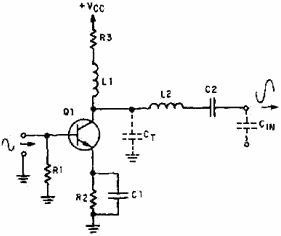
Low-Frequency Compensation is accomplished in a video amplifier
by the use of a parallel RC circuit in series with the load resistor.
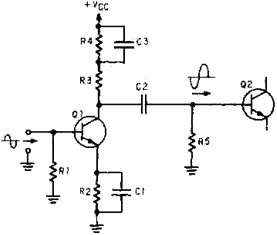
2-31
A Radio-Frequency (RF) Amplifier uses Frequency-Determining
NetworkS
to provide the required response at a given frequency.
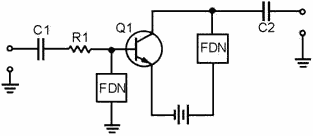
The Frequency-Determining Network in an RF amplifier provides
maximum impedance at the desired frequency. It is a parallel LC circuit which is
called a Tuned Circuit
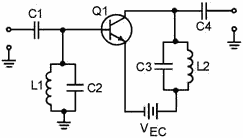
Transformer Coupling is the most common form of coupling in
RF amplifiers. This coupling is accomplished by the use of RF transformers as part
of the frequency-determining network for the amplifier.
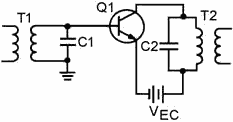
2-32
Adequate Bandpass is accomplished by optimum coupling in the
RF transformer or by the use of a SWAMPING Resistor.
Neutralization in an RF amplifier provides feedback (usually
positive) to overcome the effects caused by the base-to-collector interelectrode
capacitance.
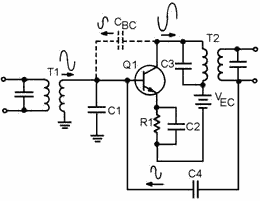
Answers to Questions Q1. Through Q42.
A-1. The difference between the upper and lower frequency limits
of an amplifier.
A-2. The half-power points of a frequency-response curve. The upper
and lower limits of the band f frequencies for which the amplifier is most effective.
A-3. (A) f2 = 80 kHz, f1 = 30 kHz, BW = 50 kHz (B) f2
= 4 kHz, f1 = 2 kHz, BW = 2 kHz
A-4. The capacitance and inductance of the circuit and the interelectrode
capacitance of the transistor.
A-5. Negative (degenerative) feedback.
A-6. It decreases.
A-7. It increases.
A-8. The capacitance of the circuit.
A-9. Peaking coils.
A-10. The relationship of the components to the output-signal path.
A-11. Combination peaking.
A-12. The coupling capacitor (C3).
2-33
A-13. a shunt peaking coil for Q2.
A-14. a decoupling capacitor for the effects of R2.
A-15. a part of the low-frequency compensation network for Q1.
A-16. a series peaking coil for Q1.
A-17. a swamping resistor for L2.
A-18. L1, L2, and R5.
A-19. R9 and C5.
A-20. The gain increases.
A-21. The gain decreases.
A-22. To provide maximum impedance at the desired frequency.
A-23. Yes.
A-24. By changing the value.
A-25. Transformer coupling.
A-26. It uses fewer components than capacitive coupling and can provide
an increase in gain.
A-27. a step-down transformer.
A-28. a too-narrow bandpass.
A-29. By using an optimally-coupled transformer.
A-30. Low gain at the center frequency.
A-31. a swamping resistor in parallel with the tuned circuit.
A-32. RF transformers are used and the transistor is neutralized.
A-33. Degenerative or negative.
A-34. By neutralization such as the use of a capacitor to provide
regenerative (positive) feedback.
A-35. C2 and the secondary of T1.
A-36. R1 provides the proper bias to the base of Q1 from VBB.
A-37. R2 provides the proper bias to the emitter of Q1.
A-38. The output would decrease. (C4 decouples R2 preventing degenerative
feedback from R2.)
A-39. C5 and the primary of T2.
A-40. Four.
2-34
A-41. The dotted lines indicate that these capacitors are "ganged"
and are tuned together with a single control.
A-42. C3 provides neutralization for Q1.
2-35
|














